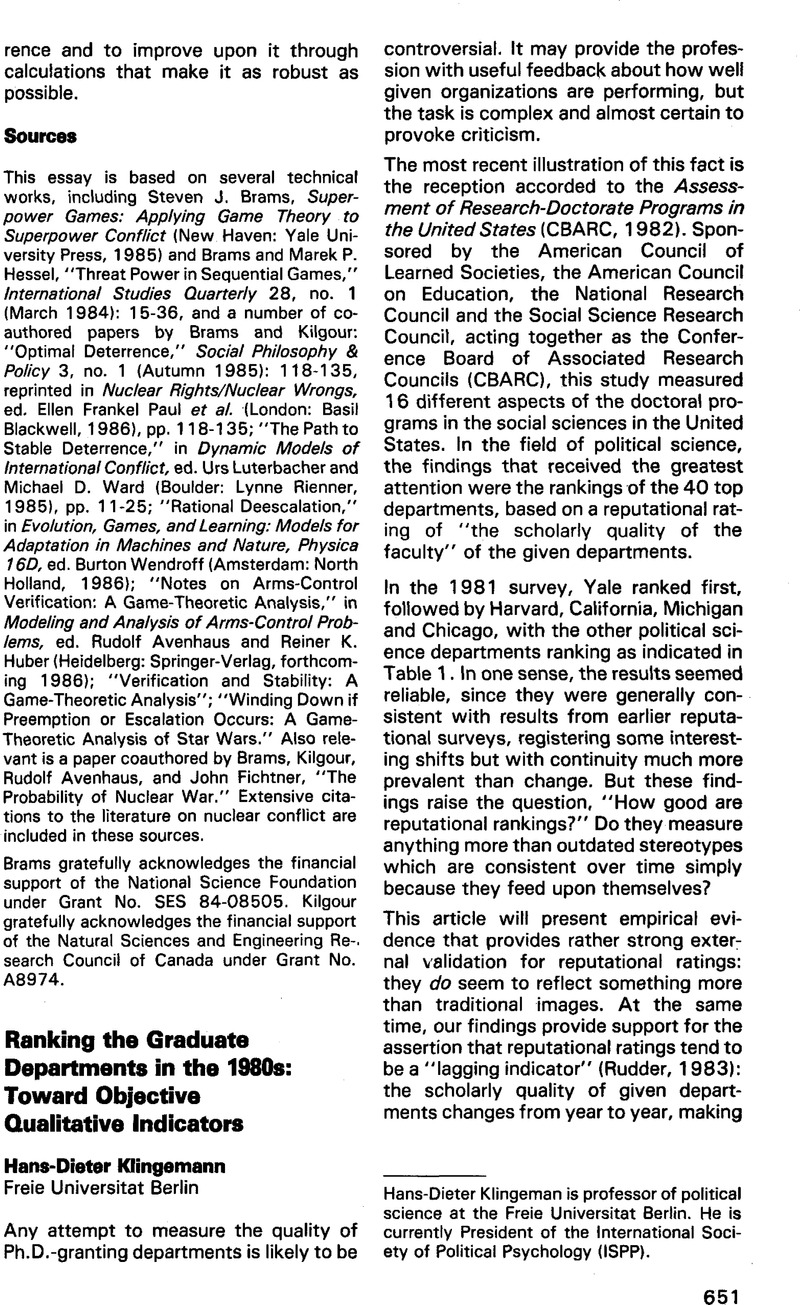Crossref Citations
This article has been cited by the following publications. This list is generated based on data provided by Crossref.
McKay, David
1988.
Why is there a European Political Science?.
PS: Political Science & Politics,
Vol. 21,
Issue. 4,
p.
1051.
McKay, David
1988.
Why is there a European Political Science?.
PS: Political Science & Politics,
Vol. 21,
Issue. 4,
p.
1051.
Klingemann, Hans-Dieter
Grofman, Bernard
and
Campagna, Janet
1989.
The Political Science 400: Citations by Ph.D. Cohort and by Ph.D.-Granting Institution.
PS: Political Science & Politics,
Vol. 22,
Issue. 2,
p.
258.
Vaughan, Donald S.
1989.
Political Science in the South--Then and Now.
The Journal of Politics,
Vol. 51,
Issue. 3,
p.
497.
Klingemann, Hans-Dieter
Grofman, Bernard
and
Campagna, Janet
1989.
The Political Science 400: Citations by Ph.D. Cohort and by Ph.D.-Granting Institution.
PS: Political Science & Politics,
Vol. 22,
Issue. 2,
p.
258.
Weale, Albert
1990.
Universities in Wonderland.
Government and Opposition,
Vol. 25,
Issue. 3,
p.
275.
Nardulli, Peter F.
1990.
Political Subcultures in the American States.
American Politics Quarterly,
Vol. 18,
Issue. 3,
p.
287.
Lester, James P.
1990.
Evaluating the Evaluators: Accrediting Knowledge and the Ranking of Political Science Journals.
PS: Political Science & Politics,
Vol. 23,
Issue. 3,
p.
445.
McKAY, DAVID
1991.
Is European political science inferior to or different from American political science *.
European Journal of Political Research,
Vol. 20,
Issue. 3-4,
p.
459.
Houston, David J.
1993.
Search for identity: the impact of the “great books” in public administration.
International Journal of Public Administration,
Vol. 16,
Issue. 5,
p.
747.
Katz, Richard S.
and
Eagles, Munroe
1996.
Ranking Political Science Programs: A View from the Lower Half.
PS: Political Science & Politics,
Vol. 29,
Issue. 2,
p.
149.
Miller, Arthur H.
Tien, Charles
and
Peebler, Andrew A.
1996.
The American Political Science Review Hall of Fame: Assessments and Implications for an Evolving Discipline.
PS: Political Science & Politics,
Vol. 29,
Issue. 1,
p.
73.
Miller, Arthur H.
Tien, Charles
and
Peebler, Andrew A.
1996.
The American Political Science Review Hall of Fame: Assessments and Implications for an Evolving Discipline.
PS: Political Science & Politics,
Vol. 29,
Issue. 1,
p.
73.
Katz, Richard S.
and
Eagles, Munroe
1996.
Ranking Political Science Programs: A View from the Lower Half.
PS: Political Science & Politics,
Vol. 29,
Issue. 2,
p.
149.
Fisher, Bonnie S.
Cobane, Craig T.
Vander Ven, Thomas M.
and
Cullen, Francis T.
1998.
How Many Authors Does It Take to Publish an Article? Trends and Patterns in Political Science.
PS: Political Science & Politics,
Vol. 31,
Issue. 4,
p.
847.
Goodson, Larry P.
Dillman, Bradford
and
Hira, Anil
1999.
Ranking the Presses: Political Scientists' Evaluations of Publisher Quality.
PS: Political Science & Politics,
Vol. 32,
Issue. 2,
p.
257.
2006.
Bevölkerung, Ungleichheit, Auslese.
p.
1.
Plümper, Thomas
2007.
academic heavy-weights: the ‘relevance’ of political science journals.
European Political Science,
Vol. 6,
Issue. 1,
p.
41.
Masuoka, Natalie
Grofman, Bernard
and
Feld, Scott L.
2007.
Ranking Departments: A Comparison of Alternative
Approaches.
PS: Political Science & Politics,
Vol. 40,
Issue. 3,
p.
531.
Houston, David
2008.
Principles And Practices Of Public Administration.



